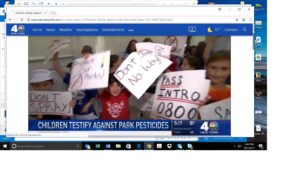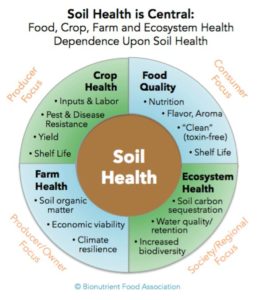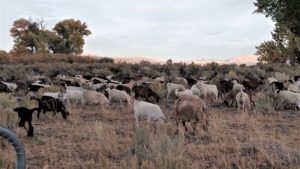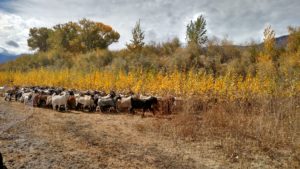(Beyond Pesticides, October 3, 2017) On August 20, the U.S. Senate was to have held a hearing on the Trump Administration’s nominee for Environmental Protection Agency Assistant Administrator for chemical safety, Michael L. Dourson, PhD. The hearing was  abruptly postponed on August 19, with no reason offered, and has not yet been rescheduled.
abruptly postponed on August 19, with no reason offered, and has not yet been rescheduled.
Dr. Dourson has spent a good deal of his career helping companies resist constraints on their use of potentially toxic compounds in consumer products. Critics, including former EPA officials, Congressional Democrats, and public health scientists say that these ties with the chemical industry, in particular, should keep him from becoming the country’s chief regulator of toxic chemicals.
U.S. Senator Tom Carper (D-DE) said, ‚ÄúDr. Dourson‚Äôs consistent endorsement of chemical safety standards that not only match industry‚Äôs views, but are also significantly less protective than EPA and other regulators have recommended, raises serious doubts about his ability to lead those efforts. This is the first time anyone with such clear and extensive ties to the chemical industry has been [nominated] to regulate that industry.‚ÄĚ
Dr. Dourson is perhaps the most recent example of the ‚Äúrevolving door‚ÄĚ phenomenon ‚ÄĒ the movement of people between roles as agency regulators or legislators, and positions in the industries that are affected by laws and regulations promulgated through those government roles. The door revolves in both directions, with folks leaving industry to join government, and vice versa. Critics say that this ready switching of roles creates unavoidable conflicts of interest and that those who do so have dubious ethical standing for undertaking the positions they seek. Indeed, ethics experts say that, if confirmed, Dr. Dourson‚Äôs work on behalf of industry could constitute significant conflicts of interest.
Dr. Dourson‚Äôs professional history provides important context in which to consider his nomination. He did a turn at EPA from 1980 to 1994, starting as a staff toxicologist. By 1989, he headed a pesticides and toxics group, supervising scientists who support EPA‚Äôs regulatory work. In 1995, Dr. Dourson started his consulting group, Toxicology Excellence for Risk Assessment, or TERA, which has done contract work for chemical companies, producing research and reports that often ‚Äúdownplayed the health risks posed by their compounds.‚ÄĚ
TERA‚Äôs clients have included Dow Chemical Company, Koch Industries Inc., and Chevron Corporation. His research has been underwritten by trade groups for companies that make pesticides, processed foods, cigarettes, and plastics, among others, including the storied American Chemistry Council. The Associated Press¬†has reported¬†that Dr. Dourson has, for some time, received payments for his critical assessments of peer-reviewed studies that identified concerns with the safety of his client companies‚Äô products. Examples of the kinds of ‚Äúindustry shielding‚ÄĚ work TERA did can be reviewed here: https://theintercept.com/2017/07/21/trumps-epa-chemical-safety-nominee-was-in-the-business-of-blessing-pollution/.
The New York Times quotes Adam Finkel,¬†executive director of the Penn Program on Regulation at the University of Pennsylvania Law School, who worked as a partner on a project with Mr. Dourson and said he observed a disturbing pattern. ‚Äú‚ÄėMost of what he has done over time is to rush headlong to exonerate chemicals,‚Äô Mr. Finkel said, adding that he stopped working with Dr. Dourson based on these concerns. ‚ÄėPretty much every piece of work he‚Äôs ever done, it just so happens that when they are finished with it, the risk is smaller than when they started, the doubt is larger, the concern is less.‚Äô The Times continues, ‚ÄúFour chemicals that are nearly ubiquitous in everyday products ‚ÄĒ¬†1,4-dioxane,¬†1-bromopropane, trichloroethylene¬†and chlorpyrifos¬†‚ÄĒ are now under review by agency regulators to determine whether they pose a threat to public health. If confirmed, [Dr.] Dourson would oversee the review of some chemicals produced by companies that his firm used to represent. . . . Each of the four chemicals has been associated with severe health issues, like cancer, birth defects and developmental problems in children. [Dr.] Dourson‚Äôs studies frequently concluded that the risk associated with these substances is much lower or more dubious than what EPA scientists and independent researchers have found.‚ÄĚ
The Associated Press reported that, when hired by Dow AgroSciences, which makes chlorpyrifos (a neurotoxic pesticide, commonly sprayed on citrus fruits and apples, that¬†harms children’s brains¬†even at very low exposure levels), Dr.Dourson and his researchers produced three papers claiming flaws in peer-reviewed studies that linked delays in fetal development with chlorpyrifos exposure. (Earlier this year, EPA Administrator Scott Pruitt overruled the findings of his agency‚Äôs own scientists to reverse an effort to ban chlorpyrifos,¬†claiming the science is “unresolved” and deciding it would push off any finding on the pesticide to 2022.) Beyond Pesticides covered this issue a few months ago in Did Dow Chemical Influence the EPA Administrator‚Äôs Decision to Reverse Chlorpyrifos Ban?
As Beyond Pesticides discussed in 2015, industry has a long history of utilizing the revolving door. When people are allowed to move from industry to regulatory agency (or the reverse) without constraint, the resultant conflicts of interest not only unduly shape policy or ratchet up industry influence, but also, cast huge doubt on the individual’s ability to act independent of industry’s interests, and in the best interest of the public and an agency’s charge.
This revolving door is not an artifact only of the current Administration, but among the bevy of people it has put forth for top-level positions in the Cabinet and as agency heads are a remarkable number with deep connections to the industries they are charged with regulating, or, in the case of Mr. Pruitt, for example, with putative animosity toward the mission of the agency. Other recent examples include: former Louisiana Senator David Vitter, who sponsored legislation in 2016 to ‚Äúreform‚ÄĚ the federal Toxic Substances Control Act (TSCA) and subsequently joined a firm that lobbies on behalf of industry, including the American Chemistry Council; and Nancy Beck, formerly a Senior Director at the American Chemistry Council, who in Spring 2017 became a Deputy Assistant Administrator of EPA‚Äôs Office of Chemical Safety and Pollution Prevention.
Beyond Pesticides called out another example a couple of years ago, noting the case of Nader Elkassabany, PhD, former branch chief of the Risk Assessment and Science Support Branch in the Antimicrobial Division in EPA’s Office of Pesticide Programs. Dr. Elkassabany left EPA to join CropLife America as Senior Director of environmental policy, where he would oversee the pesticide trade group’s regulatory strategies on environmental policy, and help manage the company’s Environmental Risk Assessment Committee and its working groups. CropLife America has been an aggressive advocate of chemical-dependent agriculture and an opponent of organic methods.
Critics consider Dr,Dourson’s nomination especially vexing at this moment, when Congress is supposed to be in the early stages of enacting its 2016 overhaul of the law that governs toxic chemicals. Unsurprisingly, industry supports his nomination and confirmation to the position.
The Harvard Edmond J. Safra Center for Ethics sums up the situation: ‚ÄúThe EPA has a vast mandate ‚ÄĒ protecting air, water, land and people from pollutants. But year after year, through both Republican and Democratic administrations and Congresses, strong economies and weak ones, the institution fails the American public in many ways. The evidence abounds. Reports by the Government Accountability Office (formerly the General Accounting Office), EPA’s own Inspectors General and the media have long documented EPA’s inability to guard Americans from toxic chemicals, mining waste, leaking Superfund sites, greenhouse gas emissions, contaminated water, air pollution and other hazards.¬†New problems also continue to appear, from the emergence of untested nanoparticles in consumer goods, to pollution from hydraulic fracking. Polls show that public trust in the EPA is down. In 2010, an advisory panel found that many agency staffers themselves believe that EPA has been hobbled by political pressure; has been forced to ignore relevant science, and is slow to act against known hazards, to avoid damaging industry. EPA has many dedicated employees who truly believe in its mission. So, why has the agency fallen short so often, since it opened its doors in 1970? A close examination of the agency shows that EPA has been corrupted by numerous routine practices, among them: the revolving door between EPA and industry [emphasis ours]; the large number of former lawmakers now lobbying to weaken environmental regulations or seek exemptions for clients; pressure from current lawmakers who are beholden to donors or who fear opposition in their next race, and other factors, including the ‚Äėburrowing in‚Äô of political appointees, and the influence of the White House Office of Management and Budget.‚ÄĚ
A decade ago there was a legislative attempt to curb this dynamic ‚ÄĒ the Honest Leadership and Open Government Act of 2007. Reviews are mixed, but data are telling. According to POLITICO: ‚ÄúNot only did the lobbying reform bill fail to slow the revolving door, it created an entire class of professional influencers who operate in the shadows, out of the public eye and unaccountable. Of the 352 people who left Congress alive since the law took effect in January 2008, POLITICO found that almost half (47 percent) have joined the influence industry: 84 as registered lobbyists and 80 others as policy advisers, strategic consultants, trade association chiefs, corporate government relations executives, affiliates of agenda-driven research institutes and leaders of political action committees or pressure groups. Taken as a whole, more former lawmakers are influencing policy and public opinion now than before the reform was enacted.‚ÄĚ
The impacts of this ongoing revolving door between (especially) EPA and industries that are highly motivated to influence regulations are enormous for public health and the health of the environment, never mind the ethical culture in government. Increasingly, members of the public feel that federal agencies are not serving and protecting the people, and are allied far too closely with corporate interests. What can ‚Äúregular‚ÄĚ folks do? Talk about this issue with local and state officials to take action in the absence of federal protection; learn more from and support organizations working for strong reform (Represent.US and Open Secrets.org are two); and advocate for stronger controls on these activities with your U.S. Representative and Senators. Get involved on a regular basis by participating in Beyond Pesticides’ Action of the Week. Contact Beyond Pesticides at [email protected] to get on our email list.
Source: https://www.nytimes.com/2017/09/19/science/epa-chemical-industry-dourson.html
 childhood brain tumors in children. According to the study, mothers who use pesticides in the home while pregnant put their children at 1.4 times the risk of developing a brain tumor under the age of 15. The study findings point to the need to eliminate the residential use of toxic chemicals by increasing education around alternative pest management practices in the home and garden, as well as regulatory action to remove toxic pesticides from the market.
childhood brain tumors in children. According to the study, mothers who use pesticides in the home while pregnant put their children at 1.4 times the risk of developing a brain tumor under the age of 15. The study findings point to the need to eliminate the residential use of toxic chemicals by increasing education around alternative pest management practices in the home and garden, as well as regulatory action to remove toxic pesticides from the market.








 uniforms. They superficially resemble fireflies (family Lampyridae), but lack light-emitting organs and the covering obscuring the head of fireflies. Like fireflies, soldier beetles are distasteful to most predators.
uniforms. They superficially resemble fireflies (family Lampyridae), but lack light-emitting organs and the covering obscuring the head of fireflies. Like fireflies, soldier beetles are distasteful to most predators. abruptly postponed on August 19, with no reason offered, and has not yet been rescheduled.
abruptly postponed on August 19, with no reason offered, and has not yet been rescheduled. bill introduced by Manhattan Councilmember Ben Kallos. ‚ÄúWe‚Äôre going to make a great big fuss,‚ÄĚ the children in Mrs. Paula Rogivin‚Äôs kindergarten class
bill introduced by Manhattan Councilmember Ben Kallos. ‚ÄúWe‚Äôre going to make a great big fuss,‚ÄĚ the children in Mrs. Paula Rogivin‚Äôs kindergarten class  sustainability. That is the take from a¬†
sustainability. That is the take from a 
 new research
new research feasibility of electronic disclosures as a means of providing consumers with information on genetically engineered (GE) food ingredients. The study, which should have been published in July 2017 by law, confirms concerns held by many that ‚Äúelectronic and digital disclosures‚ÄĚ (QR codes)¬†will pose technological challenges for consumers, limiting access to food information.¬†The study was required by the 2016¬†Federal Bioengineered Food Disclosure Standards Act¬†(the ‚Äú
feasibility of electronic disclosures as a means of providing consumers with information on genetically engineered (GE) food ingredients. The study, which should have been published in July 2017 by law, confirms concerns held by many that ‚Äúelectronic and digital disclosures‚ÄĚ (QR codes)¬†will pose technological challenges for consumers, limiting access to food information.¬†The study was required by the 2016¬†Federal Bioengineered Food Disclosure Standards Act¬†(the ‚Äú controversy is coming to a head on allowing hydroponics to be certified organic. Contrary to prior recommendations of the NOSB, the National Organic Program has allowed some hydroponics operations to be certified. The NOSB will consider motions at this meeting that could stop this practice.
controversy is coming to a head on allowing hydroponics to be certified organic. Contrary to prior recommendations of the NOSB, the National Organic Program has allowed some hydroponics operations to be certified. The NOSB will consider motions at this meeting that could stop this practice. program, led by the Washoe Tribal Environmental Protection Department (WEPD), is being conducted with the Washington, DC-based organization Beyond Pesticides and Goat Green LLC., a goat grazing company based in Wyoming.
program, led by the Washoe Tribal Environmental Protection Department (WEPD), is being conducted with the Washington, DC-based organization Beyond Pesticides and Goat Green LLC., a goat grazing company based in Wyoming.
 Department of Pesticide Regulation (DPR) decision to approve additional uses for two bee-killing pesticides without disclosing the impact on honeybees.
Department of Pesticide Regulation (DPR) decision to approve additional uses for two bee-killing pesticides without disclosing the impact on honeybees. reaching its conclusion that glyphosate (Roundup) is ‚Äúunlikely to pose a carcinogenic hazard to humans,‚ÄĚ according to recent report in
reaching its conclusion that glyphosate (Roundup) is ‚Äúunlikely to pose a carcinogenic hazard to humans,‚ÄĚ according to recent report in  soil on conventional chemical-intensive farms, according to a study conducted by researchers from Northeastern University and The Organic Center. The continuing effects of climate change necessitate a robust approach to both limiting and reducing carbon in the earth‚Äôs atmosphere. As the study shows, a wholesale transition from conventional to organic farming could play an important part in mitigating the effects of a warming planet.
soil on conventional chemical-intensive farms, according to a study conducted by researchers from Northeastern University and The Organic Center. The continuing effects of climate change necessitate a robust approach to both limiting and reducing carbon in the earth‚Äôs atmosphere. As the study shows, a wholesale transition from conventional to organic farming could play an important part in mitigating the effects of a warming planet. ‚Äďsince the administrator of EPA refused to take the action agency scientists said is necessary to protect children.
‚Äďsince the administrator of EPA refused to take the action agency scientists said is necessary to protect children. according to reports from
according to reports from  autism spectrum disorder (ASD) even when their mothers were exposed to household or agricultural pesticides. Researchers at the University of California, Davis found that taking folic acid during the window around conception, reduced the risk of pesticide-induced autism.
autism spectrum disorder (ASD) even when their mothers were exposed to household or agricultural pesticides. Researchers at the University of California, Davis found that taking folic acid during the window around conception, reduced the risk of pesticide-induced autism. from western North America have declined far more dramatically than was previously known and face a greater risk of extinction ‚Äď 86 percent in the next 50 years. The researchers do not know the exact cause but identify habitat loss and widespread pesticide use as likely culprits.
from western North America have declined far more dramatically than was previously known and face a greater risk of extinction ‚Äď 86 percent in the next 50 years. The researchers do not know the exact cause but identify habitat loss and widespread pesticide use as likely culprits. exposed to 123 pesticide residues in their daily lunches. The results call attention to the health and safety implications of pesticide exposure to children, which have developing body systems more sensitive to pesticide exposure. PAN-UK and other health groups are calling for a wholesale changeover to serving onlyorganic fruits and vegetables in schools.
exposed to 123 pesticide residues in their daily lunches. The results call attention to the health and safety implications of pesticide exposure to children, which have developing body systems more sensitive to pesticide exposure. PAN-UK and other health groups are calling for a wholesale changeover to serving onlyorganic fruits and vegetables in schools. The ice cream brand says its social mission ‚Äúseeks to meet human needs and eliminate the injustices in our local, national and international communities,‚ÄĚ and that its focus is ‚Äúon children and families, the environment and sustainable agriculture on family farms.‚ÄĚ
The ice cream brand says its social mission ‚Äúseeks to meet human needs and eliminate the injustices in our local, national and international communities,‚ÄĚ and that its focus is ‚Äúon children and families, the environment and sustainable agriculture on family farms.‚ÄĚ Wetlands improve water quality, sequester carbon, remove or neutralize pollutants, control flooding, protect adjacent areas from erosion, and host a multitude of beneficial plant and animal species ‚ÄĒ not to mention their recreational and aesthetic value.As recently reported in¬†
Wetlands improve water quality, sequester carbon, remove or neutralize pollutants, control flooding, protect adjacent areas from erosion, and host a multitude of beneficial plant and animal species ‚ÄĒ not to mention their recreational and aesthetic value.As recently reported in¬† genetically engineered (GE) food,
genetically engineered (GE) food,  demographic groups, including those in farming. People working in the transportation sector registered the highest incidence of diagnosed diabetes at 10.6%. But those working as farmers and fishermen came in second, with 8.5% reporting a diagnosis of the disease.
demographic groups, including those in farming. People working in the transportation sector registered the highest incidence of diagnosed diabetes at 10.6%. But those working as farmers and fishermen came in second, with 8.5% reporting a diagnosis of the disease. (Beyond Pesticides, September 5, 2017) The bog copper butterfly (Lycaena epixante) is a member of the second largest family of butterflies, Lycaenidae, which includes over 4,700 species worldwide. Also known as the cranberry-bog copper butterfly, the species has strong biological ties to cranberry plants and its associated habitat.
(Beyond Pesticides, September 5, 2017) The bog copper butterfly (Lycaena epixante) is a member of the second largest family of butterflies, Lycaenidae, which includes over 4,700 species worldwide. Also known as the cranberry-bog copper butterfly, the species has strong biological ties to cranberry plants and its associated habitat.
